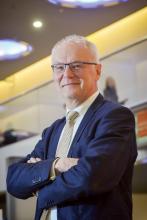Jon Taylor of Faber Maunsell and Tabatha Bailey of Transport for London describe how an unusual mix of traffic practitioners, researchers and industry are working together to build new tools for the future. As we face higher expectations for managing congestion from both citizens and politicians, and as more and more data is becoming available from new sources, our traffic management challenge is changing.

Freeflow will also look at how best to actively manage the urban/inter-urban interface
Jon Taylor of Faber Maunsell and Tabatha Bailey of Transport for London describe how an unusual mix of traffic practitioners, researchers and industry are working together to build new tools for the future
As we face higher expectations for managing congestion from both citizens and politicians, and as more and more data is becoming available from new sources, our traffic management challenge is changing. Traditionally we, as an industry, have struggled to monitor our networks effectively and when we do we have tended to collect raw data rather than focus on the bigger picture of what it all means and what we should do about it. So we need to start to turn this data into what the military have for many years called 'intelligence'. Freeflow is a project now underway to develop new tools for managing and optimising traffic as well as complementary tools for informing and guiding travellers. Both aims need a consistent flow of traffic intelligence. Using information to guide travellers is not new, but it has yet to be really used as a core tool not a separate bolt-on.Our project is part of the UK Government's Future Intelligent Transport Services (FITS) programme, one of three winners of a competition for UK Government funding. Our team is a mixture of industry experts, academic researchers and transport network operators, added to partners bringing new thinking from outside conventional transport.
The partners are
The
The project is driven by the challenge of how best to meet institutional requirements such as the UK Traffic Management Act, as well as other policies for cities and towns worldwide. A key aspect of this is the situational awareness and intelligent decision support tools we are developing. These will help traffic managers make better-informed decisions about how to solve real-time and predicted congestion. By sharing this new level of awareness of the networks with real-time information portals such as journey planners and car parking status tools, Freeflow will give a powerful new toolkit. This can influence demand from travellers directly. Through the unusual approach in which the Freeflow Consortium is working, we aim to develop a set of tools that will ultimately produce a marketable product for traffic management authorities both in the UK and worldwide.
This 'data rich, intelligence poor' situation is not a problem confined to transport, so there are already tools available to solve it. We are researching how to apply existing thinking and innovation from outside our industry to traffic management with a unique mix of network operator, industry, academic, government transport policy and government business funding. So to reflect the aims of each of these partners, the project will need to demonstrate: policy-driven benefits and outcomes (such as reduced congestion) through tools and services that offer best value to local authorities; services that have wide enough market appeal to give a return on the investment made by the commercial partners; academic research of novelty and value that can support these; and, above all, real tools that can be used in real situations by real operators.
Fulfilling this wide mix of objectives could mean re-inventing the wheel or developing tools that are already on the shelf.
So to deliver the above outcomes with fresh thinking, Freeflow's specific tasks are to: understand what traffic managers want from 'intelligent decision support' as a day-to-day tool; see how the public can then benefit from better travel information derived from this; develop new information from sensors like CCTV and also from the next generation of in-vehicle floating data, looking at how much faster data collection can be used in practice; integrate situational awareness tools, such as QinetiQ's 'Decision Desktop' (these must utilise not only data we collect now, but foster the coalition of shared intelligence that is key to current military operations); predict and model future congestion, developing beyond real-time modelling to look at the impacts of the interventions which traffic managers make; and evaluate and demonstrate benefits.
This means that Freeflow is not a system or product in itself, but a connection of many different services that a local authority user can choose. This will reflect local policy needs and must easily integrate into existing infrastructures and services. The partners have looked at the constraints and opportunities that affect the deployment of smarter travel in the real world - notably that one size does not fit all. This approach also allows greater flexibility and reduces risk in deployment. So we have an emerging set of modular tools that we will demonstrate on three widely different sites, with different policy needs and network sizes and shapes. The emphasis here is on a wide range of demonstrations to show success to both traffic managers and travelling customers.
A key part of this market-led approach is to understand the needs for both traffic managers and travellers by delivering the outcomes they desire, rather than simply repeating current technology. Hence, new products must build upon existing investments and standards, such as the UK's Urban Traffic Management and Control (
This focus on flexibility, scalability and open interoperability means that agreeing architectures and use of standards has been essential in the early stages. Having partners from outside mainstream ITS, for example QinetiQ with its military and Mindsheet with its medical sector experience, brings a new set of skills and a fresh approach to new solutions for old problems. A key focus has been on managing the chain from raw data to providing operators with enough, but not too much, useful intelligence.
Work is now underway to demonstrate these developments at three sites:
In London, Park Lane and Hyde Park Corner will show active management of one of the city's busiest junctions during day-to-day conditions and special events. This will use new data capture technology such as CCTV processing. We aim to further use the anonomised ANPR data from a wealth of detectors in London. Another potential benefit to London is allowing operators to increase their effective traffic management coverage by being alerted to potential issues before they arise.
In York, initially on the A1079 Hull Road Corridor, there will be demonstrations of enhanced bus prioritisation. This will be added to the existing UTMC system. Intelligent Decision Support will allow traffic signal settings to change in response to predicted and not just current conditions. As the project develops, we will implement pattern matching, vehicle tracking, state estimation and park-and-ride information together with the bus priority technology. This will expand along the A1036 Malton Road and A19 Fulford Road corridors, eventually to potentially cover the full city. Here the size of the city and its policy objectives contrast extremely well with London. This helps us ensure our applicability to a wider market.
In Kent, the Consortium will be looking at managing congestion in Maidstone, particularly when there are problems from traffic on the nearby motorway network. Although Maidstone is similar in many ways to York in terms of size and policies, having a neighbouring motorway between London and the Channel Ports is a significant difference. If incidents occur on the motorway, this can cause significant problems that local traffic managers need to address. Kent County Council is working with the Highways Agency and Medway Council via their Cordon project. Through this mixture, we will show how to actively manage the urban/inter-urban interface. Again this is of wide use in the UK but also far wider as many cities face the same cross-border issues.
We already have plans to evaluate the benefits from the demonstrations against measures of success defined by the partners. These are again a mix reflecting the partners' interests, including: their desired policy outcomes; the market for products that the project develops; and the global applicability beyond the UK.
In terms of commercial partners, Mindsheet, TrakM8 and Kizoom are developing direct services to inform travellers, while QinetiQ brings its Decision Desktop to allow quicker decisions based on better information. ACIS is building a data warehouse which allows UTMC-compliant developments and research without impacting on live UTMC systems. This will allow Intelligent Decision Support tools to access existing data sources too.
The University of York and Imperial College London will build network prediction and pattern recognition software, while Loughborough University is focusing on developing new CCTV tools.
Such a wide range of partners from different backgrounds has provoked innovative thinking about how to exchange knowledge and develop collaborative designs. Gaining a free flow of knowledge within the project mirrors our overall aims of the flow of data into information and flow of intelligence provided by technology. The project is now gaining momentum and we hope to share our results with you soon.










